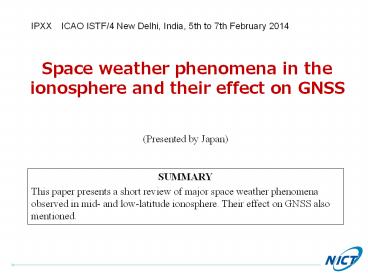Ionospheric Observations Using GEONET Data - PowerPoint PPT Presentation
Title:
Ionospheric Observations Using GEONET Data
Description:
... (increase, disappearance, hemispheric asymmetry, etc) Affected by magnetic ... 12:40 UT (21:40 JST) 13:00 UT (22:00 JST) 3D simulation of plasma bubble ... – PowerPoint PPT presentation
Number of Views:131
Avg rating:3.0/5.0
Title: Ionospheric Observations Using GEONET Data
1
IPXX ICAO ISTF/4 New Delhi, India, 5th to 7th
February 2014
Space weather phenomena in the ionosphere and
their effect on GNSS
(Presented by Japan)
SUMMARY This paper presents a short review of
major space weather phenomena observed in mid-
and low-latitude ionosphere. Their effect on GNSS
also mentioned.
2
Sudden Ionospheric Disturbance (SID)
SOHO/SEM EUV count/s
GOES X-ray flux W/m2
35
GPS TEC TECU
0
TIMED/GUVI O, N2 R
10
15
UT hour
Tsurutani et al., 2005
Tsugawa et al., 2007
3
Sudden Ionospheric Disturbance (SID)
Amplitude Several 10 TECU Depending on flare class
Time scale Increase in several minutes Enhancement lasts for several hours
Spatial structure Global scale in the sunlit hemisphere Depending on solar zenith angle
Other characteristics HF radio absorption (Dellinger phenomena) Possibility of loss-of-lock on GNSS signals due to solar radio burst
Effect on GNSS Augmented GPS (due to TEC model correction error) Loss-of-lock on GPS signals
4
Ionospheric Storm
One-month Average
Negative Storm
Positive Storm
Kp
5
Ionospehric Storm
Amplitude Several 10 TECU compared to quiet conditions
Time scale Several hours to several days
Spatial structure Small spatial TEC gradient
Other characteristics Basically occurring during and/or after magnetic storms
Effect on GNSS Augmented GPS (due to TEC model correction error)
6
Equatorial Ionization Anomaly
2040 JST, 23 Jan 2002
2040 JST, 24 Jan 2002
7
Equatorial Ionization Anomaly
Amplitude Several 10 TECU
Time scale
Spatial structure Large latitudinal TEC gradient
Other characteristics Day-to-day variation is not negligible (increase, disappearance, hemispheric asymmetry, etc) Affected by magnetic storms
Effect on GNSS Augmented GPS (due to TEC model correction error)
8
Storm enhanced density (SED)
Foster et al., JGR, 2005
9
Short summary of SED
Amplitude Several 10 to 100TECU
Time scale Several hours (?)
Spatial structure Steep horizontal TEC gradient Narrow in zonal direction Extending in NW-SE direction
Other characteristics Often observed from noon to sunset during the large geomagnetic storm Sometimes accompanied with ionospheric irregularity
Effect on GNSS Differential GPS Augmented GPS (due to TEC model correction error) Loss-of-lock on GPS signals
10
GPS-TEC Observations for Space Weather
Absolute TEC
ROTI (10km scale irregularity)
Loss-of-Lock (100m scale irregularity)
1220 UT (2120 JST)
1240 UT (2140 JST)
1300 UT (2200 JST)
3D simulation of plasma bubble Courtesy of Dr.
T. Yokoyama (NICT)
11
Short summary of EPB
Amplitude -Several 10 to -100TECU
Time scale Several 10 minutes to several hours
Spatial structure Steep horizontal TEC gradient Narrow in zonal direction Extending along the magnetic field line
Other characteristics Often observed mid- to low latitudes after the sunset. Almost always accompanied with ionospheric irregularity
Effect on GNSS Differential GPS Augmented GPS (due to TEC model correction error) Loss-of-lock on GPS signals
12
Traveling Ionospheric Disturbances (TID)
Large -scale TID (LSTID)
Tsugawa et al., JGR., 2003
Medium -scale TID (MSTID)
Tsugawa et al., GPS solut., 2007
13
Traveling Ionospheric Disturbances (TID)
Amplitude A few TECU
Time scale MS Several 10 minutes LS Several hours
Spatial structure MS Wavelengths of several 100 km LS Wavelengths of 1,000 3,000 km, Zonally extended wavefront
Other characteristics MS Southwestward and Southeastward propagations in nighttime and daytime, respectively. LS Related with magnetic storm
Effect on GNSS Differential GPS Augmented GPS (due to TEC model correction error)
14
Summary of Ionospheric Space Weather Phenomena
Solar Act./ Mag. Storm dependence
SED
Amplitude
Large
SID
LSTID
Med.
Ion. Strom
Eq. Ion. Anomaly
Small
Plasma Bubble
Lower Atm. dependence
MSTID
Sporadic E
10km
100km
1000km
Global
Spatial Scale































